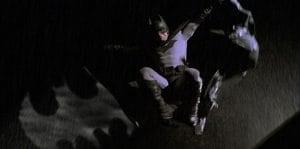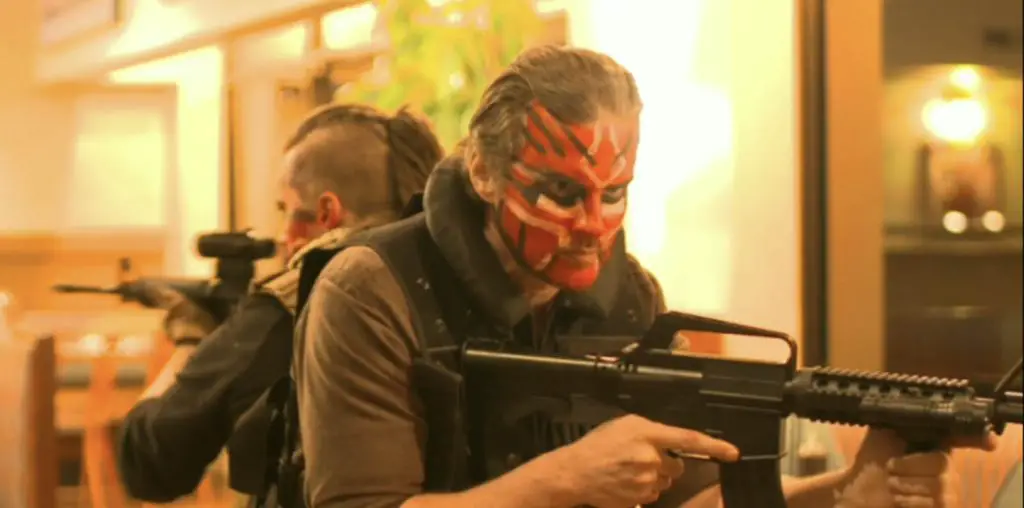
Every aspiring director in Hollywood needs a calling card to break into feature films. For Steven Spielberg, it was the short film Amblin’. For Christopher Nolan, it was the low-budget thriller Following. In the case of Sandy Collora, subject of the documentary Behind The Mask: The Batman Dead End Story, it was something more bizarre: a fan film in which Batman fights the Joker, Alien, and Predator.
Born in New York to an Italian-American family, Sandy Collora moved to Los Angeles at a young age with dreams of directing. Genre filmmaking and comic books were his passion—Star Wars inspired him to become a filmmaker—and he was a child prodigy when it came to creature designs and world building. He arrived in Hollywood as a teenager with an already impressive portfolio, and soon he was working under the wing of major art designers and technicians. Everything seemed lined up for him to become a world-famous director.
And yet…Sandy Collora isn’t a household name. While his short film Batman: Dead End made a huge splash at San Diego Comic Con and got praise from Kevin Smith, the film and its creator have been lost to history. Behind The Mask tells the story of how this happened in three parts: a first act that covers Collora’s early career as a special effects technician, a second act that goes into the making of Batman: Dead End, and a final act that covers the film’s success and how Collora dropped the ball afterwards. These elements combine into a well-crafted, if sometimes unconvincing, portrait of a talented filmmaker whose ego was too big for the Hollywood studios.
“…a well-crafted, if sometimes unconvincing, portrait of a talented filmmaker whose ego was too big for Hollywood.”
The first part, composed of interviews with Collora, his family, and his early Hollywood contacts, is the strongest. It’s a well-rounded look at Collora’s formative years as an ambitious film geek, then effects designer, then commercial director. Collora’s talent for eye-popping creature designs comes through, and so does his passion for film and love of genre film history. Through modern testimonials and archival footage, we also see his arrogant side and lack of respect for the Hollywood pecking order. Through these contrasting impressions of people close to Collora, director Eric Dow gets us to like him as a flawed but endearing guy who we want to succeed as a feature filmmaker.
To get there, Collora had to make something that would impress the studios. In the pre-Batman Begins era when mainstream filmgoers only knew of campy batsuit-nipples Batman, he wanted to put the darker caped crusader from the comics on screen. This brooding, mature Batman would then fight Alien and Predator (it sounds ridiculous, but Batman actually fights these monsters in the DC comic book canon). Behind The Mask sells us on the idea that this could be a great short that gives comic book fans what they always wanted.
Unfortunately, when it comes time to tell the behind-the-scenes story of Batman: Dead End, Collora along with his foibles play second fiddle to how cool and amazing the short film was. The makers of Behind The Mask are clearly fans of Collora’s work, and they understandably want to give Collora some of the recognition that he has been denied. However, the middle 30 minutes of the movie focused too much on the Batman: Dead End concept, the high production values, the dedicated actors, the well-made props, and the iconic shots of Batman’s cape. The movie loses track of the character study that it had set up so well. We learn that Collora persevered in the making of the film despite a huge personal tragedy, but what was his directing style? How did he get along with people on set? Was he able to have the coolheaded vision of his idol James Cameron, or did he strain under the pressure? If the film had addressed these issues, it would have felt less like an advertisement for a 15-year-old fan movie.
“…strains to make the audience sympathize with the hot-headed Collora.”
Thankfully, the third act returns to the story of Collora and how his difficult personality got in the way of a feature film deal. Without spoiling anything, Dow is a great interviewer, and there are some great scenes of the older, wiser Collora confronting his past embarrassing behavior. It’s hard to watch the last third of the movie and not yell at your TV about how this guy laid waste to his golden opportunity, especially since he was so well-versed in Hollywood mythology. Yet the movie ends on a happy note, suggesting that even if you don’t achieve your wildest dreams, you can find fulfillment in your accomplishments, whatever they are.
At times, Behind The Mask strains to make the audience sympathize with the hot-headed Collora. Getting people to like a truly arrogant person is hard, and there are times when you can see the seams of the film trying to tell a specific heartwarming story. The film doesn’t erase Collora’s rough edges, but it blunts them to the movie’s detriment. How good could this movie have been if it asked deeper questions about artistic personalities or the human cost of filmmaking? As it is, it’s a charming, diverting tale of hard work and passion that paid off, if only for a short while.

Behind The Mask: The Batman Dead End Story (2015) Written and directed by Eric Dow. Starring Sandy Collora, Kurt Carley, Sean Clark, Clark Bartram, and Neal Adams.
4 out of 5 stars

